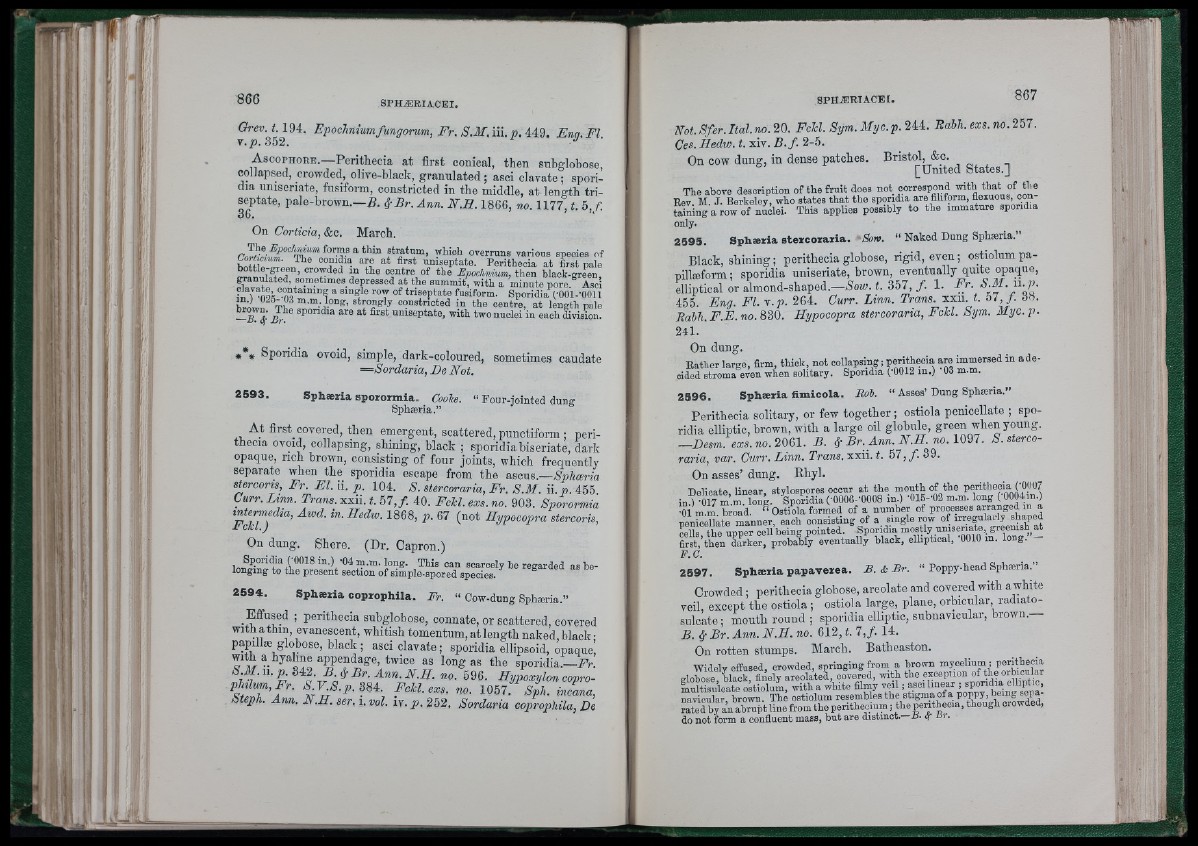
L
J l L
Grev. 1.194. Epochnium fungorum, Fr. S.M. iii. ». 449. Ena. F l
v.p . 352. ^ S
A scophore.— Perithecia at first conical, then snbglobose
collapsed, crowded, olive-black, granulated ; asci clavate ; sporidia
uniseriate, fusiform, constricted in the middle, at length triseptate,
pale-brown.—®. ^®r. Ann. N.H. 1866, no. 1177, t. 5, f.
36.
On Corticia, &c. March.
® ft™*"“ , wliiet overruns various species of
Corto«™. The conidia are at first uniseptate. Perithecia at first pale
a ’ the Epochnium, then hlack-green,
rin vnfo ’1 °“ ® • ‘*^® with clavate containing a single row of triseptate fusiform. a Smpionruidtei ap CorOeO. l-'OAOsclli
W w ? TL strongly constricted in the centre, at length pale
—B 5-' b FF uniseptate, with two nuclei iu each division.
»** Sporidia ovoid, simple, dark-coloured, sometimes caudate
=Sordaria, Be Not.
2 5 9 3 . Sphaeria sporo rmia. Coolie. “ Four-iointed dung
Sphæria.”
At first covered, then emergent, scattered, punctiform ; perithecia
ovoid, collapsing, shining, black ; sporidia biseriate, dark
opaque rich brown, consisting of four joints, which frequently
separate when the sporidia escape from the ascus.—Svhceria
stercoris, Fr. El. ii. p. 104. S. stercoraria, Fr. S.M. iCp. 455
tu rr. Lmn. Draw. xxii. f. 57,/. 40. FcU.exs.no. 903. Sporormia
'fFu ) Hypocopra stercoris,
On dung. Shere. (Dr. Capron.)
Spondia (-0018 in.) -04 m.m. long. This can scarcely he regarded as he-
longing to the present section of simple-spored species.
2 5 9 4 . Sphaeria copro phila . Fr. “ Cow-dung Sphæria.”
Effused ; perithecia subglobose, connate, or scattered, covered
with a thin, evanescent, whitish tomentum, at length naked, black ;
papillæ globose, black; asci clavate; sporidia ellipsoid, opaque
with a hyalme appendage, twice as long as the sporidia.—Ur.
■ F ^ 3 2 . B.& Br. Ann. N.H. no. 596. Hypoxylon copropMum,
Fr. S V S .p . 384. FcU. exs. no. 1057 Sph. incana,
Steph. Ann. N.H. ser, i. vol. iv. p . 252, Sordaria coprophila, Be
Not.Sfer.Ital.no. 20. FcU. Sym. Myc.p. 244. Bahh. exs. no. 257.
Ces. Èedw.t. xiv. B . f 2-5.
On cow dung, in dense patches. Bristol, &_c.
[United States.]
The above description of the fruit does not correspond with that of the
Rev M J. Berkeley, who states that the spondia are filiform, flexuous, containing
a row of nuclei. This applies possibly to the immature sporidia
only.
2 5 9 5 . Sphæ ria ste rco ra ria . Son. “ Naked Dung Sphæria.”
Black, shining ; perithecia globose, rigid, even ; ostiolum papillæform
; sporidia uniseriate, brown, eventually quite opaque,
elliptical or almond-shaped.—Sow. t. 357, / . 1. Fr. S .M .u . p.
455. Eng. Fl. v.p. 264. Curr. Linn. Trans, xxii. t. 5 7 , / 38.
Rabh. F .E . no. 830. Hypocopra stercoraria, FcU. Sym. Myc. p.
241.O
n dung.
Bather large, firm, thick, not collapsing ; p e /th e ria are immersed in a decided
stroma even when solitary. Spondia (-0012 in.) 03 m.m.
2 5 9 6 . S p h æ r ia f im ic o la . Rob. “ Asses’ Dung Sphæria.”
Perithecia solitary, or few together ; ostiola penicellate ; sporidia
elliptic, brown, with a large oil globule, green when young.
— Besm. exs.no.2061. B. & B r .fn n . N.H. n o .l097. S. stercoraria,
var. Curr. Linn. Trans, xxii. t. 57, f 39.
On asses’ dung. Rhyl.
Delicate, linear, stylospores occur at the mouth of the perithecia C0«07
in 1 -017 m m. long. Sporidia (-0006--0008 in.) •01/-02 m.m. long ( 0004m.)
■01 m m hraad. « Ostiola formed of a number of processes arranged in a
penicellate manner, each consisting of a single row
cells, the upper cell being pointed. Sporidia
first then darker, probably eventually black, elhptical, 0010 in. long.
F.C.
2 5 9 7 . Sp hæ ria p a p a v e r e a . B .& B r . “ Poppy-head Sphæria.”
Crowded ; perithecia globose, areolate and covered with a white
veil, except the ostiola ; ostiola large, plane, orbicular radiato-
sulcate; mouth round ; sporidia elliptic, suhnavicnlar, brown.—
®. & Br. Ann. N .H. no. 612, t. 7 , f 14.
On rotten stumps. March. Batheaston.
Widely effused, crowded, springing from a brown mycelium ;
globose black, finely areolated, covered, with the exception of the o^A®/'®;'’
multisulcate ostiolum with a white filmy veil ; asci linear ; spondia elhptic,
navicular brown. The ostiolum resembles the stigraaofa poppy, being separated
by an abrupt line from the perithecium ; the perithecia, though crowded,
do not form a confluent mass, but are distinct.—B. 4 isr.